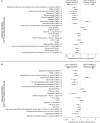Kidney Biopsy Features Most Predictive of Clinical Outcomes in the Spectrum of Minimal Change Disease and Focal Segmental Glomerulosclerosis
- PMID: 35581011
- PMCID: PMC9257823
- DOI: 10.1681/ASN.2021101396
Kidney Biopsy Features Most Predictive of Clinical Outcomes in the Spectrum of Minimal Change Disease and Focal Segmental Glomerulosclerosis
Abstract
Background: Heterogeneity in disease course and treatment response among patients with MCD/FSGS necessitates a granular evaluation of kidney tissue features. This study aimed to identify histologic and ultrastructural descriptors of structural changes most predictive of clinical outcomes in the Nephrotic Syndrome Study Network (NEPTUNE).
Methods: Forty-eight histologic (37 glomerular, 9 tubulointerstitial, 2 vascular) and 20 ultrastructural descriptors were quantified by applying the NEPTUNE Digital Pathology Scoring System to NEPTUNE kidney biopsies. Outcomes included time from biopsy to disease progression, first complete remission of proteinuria, and treatment response. Relative importance of pathology and clinical predictors was obtained from random forest models, and predictive discrimination was assessed.
Results: Among 224 participants (34% Black, 24% Hispanic), model performance was excellent, with predictive discrimination of 0.9 for disease progression, 0.85 for complete remission, and 0.81 for treatment response. The most predictive descriptors of outcomes included both conventional-e.g., global sclerosis or segmental sclerosis and interstitial fibrosis/tubular atrophy-and novel features, including adhesion, interstitial foam cells, deflation, periglomerular fibrosis, mononuclear white blood cells, endothelial cell abnormalities, microvillous transformation, and acute tubular injury.
Conclusions: The most predictive descriptors of clinical outcomes among MCD/FSGS patients reflected structural changes in multiple renal compartments. Reporting these descriptors should be standardized to guide prognostication of proteinuric glomerular diseases.
Keywords: glomerular disease; kidney biopsy; nephrotic syndrome; outcome prediction; renal morphology.
Copyright © 2022 by the American Society of Nephrology.
Figures







Comment in
-
Predicting Future Outcomes from Kidney Biopsies with MCD/FSGS Lesions: Opportunities and Limitations.J Am Soc Nephrol. 2022 Jul;33(7):1233-1235. doi: 10.1681/ASN.2022040506. Epub 2022 Jun 21. J Am Soc Nephrol. 2022. PMID: 35728879 Free PMC article. No abstract available.
References
-
- Barisoni L, Schnaper HW, Kopp JB: A proposed taxonomy for the podocytopathies: A reassessment of the primary nephrotic diseases. Clin J Am Soc Nephrol 2: 529–542, 2007 - PubMed
-
- Diamond MJ, Atwater S, Nahman NS: Spectrum of Minimal Change Disease to Focal Segmental Glomerulosclerosis. Encyclopedia of Medical Immunology, New York, Springer, 2014, pp 1093–1099
-
- Fogo AB: The spectrum of FSGS: Does pathology matter? Nephrol Dial Transplant 25: 1034–1036, 2010 - PubMed
-
- Maas RJ, Deegens JK, Smeets B, Moeller MJ, Wetzels JF: Minimal change disease and idiopathic FSGS: Manifestations of the same disease. Nat Rev Nephrol 12: 768–776, 2016 - PubMed
-
- Stokes MB, Markowitz GS, Lin J, Valeri AM, D’Agati VD: Glomerular tip lesion: A distinct entity within the minimal change disease/focal segmental glomerulosclerosis spectrum. Kidney Int 65: 1690–1702, 2004 - PubMed
Publication types
MeSH terms
Grants and funding
LinkOut - more resources
Full Text Sources
Other Literature Sources
Medical
Molecular Biology Databases

